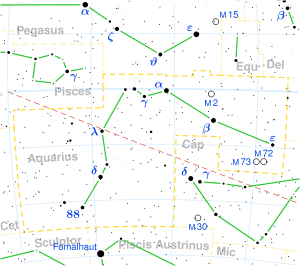Tau2 Aquarii
- For other star systems with this Bayer designation, see Tau Aquarii.

| |
| Observation data Epoch J2000 Equinox J2000 | |
|---|---|
| Constellation | Aquarius |
| Right ascension | 22h 49m 35.50157s[1] |
| Declination | –13° 35′ 33.4767″[1] |
| Apparent magnitude (V) | +4.042[2] |
| Characteristics | |
| Spectral type | K5 III[3] |
| U−B color index | +1.948[2] |
| B−V color index | +1.566[2] |
| Astrometry | |
| Radial velocity (Rv) | +1.0[4] km/s |
| Proper motion (μ) | RA: –13.71[1] mas/yr Dec.: –39.03[1] mas/yr |
| Parallax (π) | 10.27 ± 0.29[1] mas |
| Distance | 318 ± 9 ly (97 ± 3 pc) |
| Absolute magnitude (MV) | −1.28[5] |
| Details | |
| Radius | 53[6] R☉ |
| Other designations | |
Tau2 Aquarii (τ2 Aqr, τ2 Aquarii) is the Bayer designation for a star in the equatorial constellation of Aquarius. It is visible to the naked eye with an apparent visual magnitude of +4.0.[2] This is an orange-hued[8] giant star with a stellar classification of K5 III.[3] The measured angular diameter, after correction for limb darkening, is 5.12 ± 0.05 mas.[9] At an estimated distance of 318 light-years (97 parsecs) based on parallax measurements,[1] this yields a physical size of about 53 times the radius of the Sun.[6]
References
- 1 2 3 4 5 6 van Leeuwen, F. (November 2007), "Validation of the new Hipparcos reduction", Astronomy and Astrophysics, 474 (2): 653–664, arXiv:0708.1752
 , Bibcode:2007A&A...474..653V, doi:10.1051/0004-6361:20078357.
, Bibcode:2007A&A...474..653V, doi:10.1051/0004-6361:20078357. - 1 2 3 4 Gutierrez-Moreno, Adelina; et al. (1966), "A System of photometric standards", Publ. Dept. Astron. Univ. Chile, Publicaciones Universidad de Chile, Department de Astronomy, 1: 1–17, Bibcode:1966PDAUC...1....1G.
- 1 2 Houk, Nancy (1978), "Michigan catalogue of two-dimensional spectral types for the HD stars", Michigan Catalogue of Two-dimensional Spectral Types for the HD Stars. Volume 4, Ann Arbor: Dept. of Astronomy, University of Michigan, 4, Bibcode:1988mcts.book.....H.
- ↑ Wielen, R.; et al. (1999), "Sixth Catalogue of Fundamental Stars (FK6). Part I. Basic fundamental stars with direct solutions", Veröff. Astron. Rechen-Inst. Heidelb, Astronomisches Rechen-Institut Heidelberg, 35 (35), Bibcode:1999VeARI..35....1W.
- ↑ Pace, G.; Pasquini, L.; Ortolani, S. (2003). "The Wilson-Bappu effect: A tool to determine stellar distances". Astronomy and Astrophysics. 401 (3): 997. arXiv:astro-ph/0301637
 . Bibcode:2003A&A...401..997P. doi:10.1051/0004-6361:20030163.
. Bibcode:2003A&A...401..997P. doi:10.1051/0004-6361:20030163. - 1 2 Lang, Kenneth R. (2006), Astrophysical formulae, Astronomy and astrophysics library, 1 (3rd ed.), Birkhäuser, ISBN 3-540-29692-1. The radius (R*) is given by:
- ↑ "tau Aqr -- Star in double system", SIMBAD, Centre de Données astronomiques de Strasbourg, retrieved 2012-02-08
- ↑ "The Colour of Stars", Australia Telescope, Outreach and Education, Commonwealth Scientific and Industrial Research Organisation, December 21, 2004, retrieved 2012-01-16
- ↑ Richichi, A.; Percheron, I.; Khristoforova, M. (February 2005), "CHARM2: An updated Catalog of High Angular Resolution Measurements", Astronomy and Astrophysics, 431 (2): 773–777, Bibcode:2005A&A...431..773R, doi:10.1051/0004-6361:20042039
External links
This article is issued from Wikipedia - version of the 10/23/2016. The text is available under the Creative Commons Attribution/Share Alike but additional terms may apply for the media files.